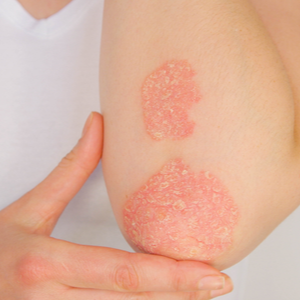
What is psoriasis?
Psoriasis is an inflammatory, but not contagious skin disease. The typical appearance of psoriasis is scaly, reddish skin changes, which may also be itchy. Patients who have psoriasis chronically sometimes suffer from no skin problems at all or from mild or severe skin problems. Although psoriasis can be treated effectively, the disease is not curable and can be psychologically very stressful, especially when the skin changes appear on visible parts of the body. According to estimates, about 2 percent of the population in Germany suffer from psoriasis.
What causes psoriasis?
In psoriasis, the problem lies in the horn-forming cells (keratinocytes). Normally, keratinocytes pass through the top layer of skin (epidermis) within about four weeks. In the case of psoriasis, the keratinocytes divide about 10 times as fast and only need about four days to reach the skin surface. Since the dead cells cannot be shed quickly enough, the affected skin area becomes thick and starts to flake.
What promotes the development of psoriasis?
Psoriasis is mainly caused by genetic factors and is therefore the biggest risk factor. If one of the parents already suffers from psoriasis, there is a 15 percent chance that the child will also develop the disease. This probability increases to 40 percent if both parents suffer from psoriasis. So far, there are no preventive measures to protect the development of psoriasis.
What are the differences in the clinical picture?
Doctors usually distinguish between different types of psoriasis. In 80 percent of all cases, the so-called psoriasis vulgaris (or plaque psoriasis) is the most common form. Psoriasis vulgaris can sometimes also cause nail psoriasis. In this case, there is a change in the nails, which manifests itself, for example, through a thickening of the nail, small dents in the nail or yellowish-brown discolouration (so-called oil nail). In particularly severe cases, the nail may also become detached.
In addition to these two forms of psoriasis, there is also psoriasis inversa (or psoriasis intertriginosa), which occurs mainly in skin folds, for example under the armpits, in the groin or buttock folds, in the genital area or, in female patients, under or between the breasts. This type of psoriasis is usually not scaly, as the skin in the affected areas of the body tends to be moist.
Pustular psoriasis is another type of psoriasis where the skin forms pus-filled blisters and occurs either with psoriasis vulgaris or alone. Psoriasis guttata, another form of psoriasis, is rather rare and is characterised by a large skin rash with pinpoint papules. This type of psoriasis mainly affects children and adolescents and often appears one to two weeks after a streptococcal infection. After this infection is cured, the psoriasis guttata can also disappear completely, or it can recur or turn into psoriasis vulgaris.
What are the symptoms of psoriasis?
The most common form of psoriasis, psoriasis vulgaris, is characterised by the following symptoms:
- reddening of the skin, usually on both sides, which is usually accompanied by a silvery, shiny and very scaly elevation of the skin, called plaques, because they are very different from the rest of the skin,
- typical body parts are the elbows, knees, head and back. But plaques can also appear behind the ears, on the hands as well as on the feet or on the belly button. They can reach a diameter of between one and more than ten centimetres,
- severe psoriasis can also be accompanied by intense itching,
- Psoriasis on the hands and feet can be accompanied by very dry skin that is in danger of tearing.
What is the course of psoriasis?
In most cases, psoriasis progresses in episodes, i.e. there are times when patients complain of particularly severe symptoms and times when the psoriasis is hardly noticeable. Still other patients suffer from psoriasis that is permanently severe. Doctors have recently discovered that psoriasis can be triggered by certain stimuli. These include sunburn, hot showers, certain chemicals and medicines, such as those used to treat malaria, and minor injuries to the skin's surface. In addition, psychological stress, infections and the consumption of nicotine and alcohol can also favour the onset of psoriasis.
What are the health consequences of psoriasis?
Psoriasis is usually accompanied by an autoimmune reaction that not only affects the skin but also other parts of the body. About 25 percent of all patients with psoriasis also complain about inflamed joints (psoriatic arthritis). To prevent joint damage, it should be treated early.
In addition to a possible psychological burden, patients with psoriasis also tend to have an increased cardiovascular risk. Psoriasis therefore often occurs together with diabetes, high blood pressure, high cholesterol levels and/or severe obesity. In addition, chronic inflammatory bowel diseases such as Crohn's disease occur more often on average in connection with psoriasis.
How is psoriasis treated?
Psoriasis can be treated by intensive skin care, for example. This involves rubbing oily ointments and/or creams on the affected areas of the skin to prevent it from drying out, to protect the skin from injury, and to relieve itching if necessary. In the case of moderate to severe psoriasis, light therapy can also be used. The plaques are irradiated with UV light to reduce the inflammation of the skin and slow down cell division. Alternatively, patients can also be given medication or injections. These are intended to inhibit the immune system's defence reactions.
